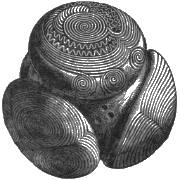Canmore Site 31321: SILLERHOLE, CARAVAN PARK - SCOONIE (KIRKCALDY) - CEMETERY (PREHISTORIC), CIST(S) (BRONZE AGE), CREMATION (PREHISTORIC), HUMAN REMAINS (PREHISTORIC), BEAD (JADE )(PREHISTORIC), BLADE (STONE)(PREHISTORIC), FOOD VESSEL (BRONZE AGE)
Description
| Site Name | SILLERHOLE, CARAVAN PARK |
|---|---|
| Other Name(s) | LEVEN, HOLLY ROAD |
| Site Number | NO30SE 1 |
| Broad Class | MANUFACTURING AND PROCESSING, DRESS AND PERSONAL ACCESSORIES, TOOLS AND EQUIPMENT, RELIGIOUS RITUAL AND FUNERARY, CONTAINER |
| Site Type(s) | CEMETERY (PREHISTORIC), CIST(S) (BRONZE AGE), CREMATION (PREHISTORIC), HUMAN REMAINS (PREHISTORIC), BEAD (JADE )(PREHISTORIC), BLADE (STONE)(PREHISTORIC), FOOD VESSEL (BRONZE AGE) |
| NGR | NO 3783 0213 |
| NGR accuracy | NGR given to the nearest 10m |
| Local Authority | FIFE |
| Parish | SCOONIE (KIRKCALDY) |
| Record created | 1988-02-22 |
| Last updated | 2006-10-06 |
Archaeology Notes
NO30SE 1 3783 0213.
(NO 377 021) A short cist containing skeletal fragments of at least two people, a single Early Bronze Age jet bead, and some charcoal, was examined in June 1944. It lay about half a mile south-east of Durie House on the top of a slight rise in field No.338.
R L Christie 1951
The site of the cist is at NO 3783 0213, where there is now only a hole, with a stone slab (?the cover stone) lying to the south of it (R L Christie, Durie House).
Visited by OS (RDL) 19 October 1962
NO 378 021 A cist cemetery consisting of at least eight cists was discovered during an archaeological evaluation in May 2002 at Holly Road, Leven. The cists were recorded in plan and the ground reinstated. No further excavation took place. Decorated pottery of early prehistoric date was associated with the cists. It is likely that a cist discovered in 1944 (PSAS 83, 230-31) is one of the eight uncovered by the evaluation. (AOC 3786)
Archive to be deposited in the NMRS.
Sponsor: Boyack Homes.
K Stentoft 2002
NO 377 021 A field evaluation, undertaken by AOC Archaeology in advance of a proposed housing development (see above), uncovered eight cists in the vicinity of one discovered in 1944. Following the completion of the evaluation, the site was backfilled. In July 2002, the site was reopened and over the next three weeks excavated fully. The first phase of that project was undertaken by the Time Team, the remainder by Scotia Archaeology.
In all, 11 cists were uncovered. Six of them were surrounded by a ditch which had been deliberately filled in before at least some of the burials were in place. The penannular ditch defined an enclosure 9-10m in diameter, seemingly with an entrance on its E side, although only one terminal could be identified because of severe erosion in that part of the trench. On the S side of the enclosure was the largest of the cists, over which sat a hemispherical boulder, 2.5m in diameter. Only this cist and one other retained their capstones. Those graves outside the enclosure were of significantly inferior quality to those inside it, and appeared to include child burials. One cremation burial was uncovered in the NW corner of the enclosure. The complete excavation of the site, including the removal of several spits of fluvio-glacial materials, failed to reveal any more.
The preservation of human remains varied considerably, from almost complete skeletons in some graves to a total lack of bone in others. The artefactual assemblage consists of one flint knife blade, three complete Food Vessels (one much smaller than the others), and several sherds from another vessel.
Sponsor: Fife Council.
J Lewis 2002
Identifiers and Links to Other Records
Would you like to help find more links?
This area is visible only to logged in users.
